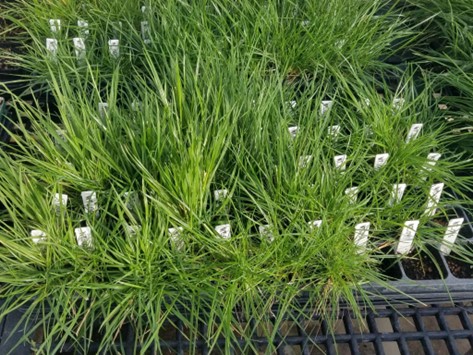By Kate Freund
This article was originally published on the WinterTurf project blog.
Perennial ryegrass (Lolium perenne) is an economically important turfgrass and forage grass (Figure 1). Although its rapid germination and quick establishment make it a valuable component of lawns, its use in northern climates is limited by its susceptibility to prolonged periods of extreme low temperatures. A plant’s tolerance to freezing is the result of various physiological and metabolic changes that occur during the cold acclimation (increase in freezing tolerance upon exposure to low temperatures) process. Previous research has identified genes associated with cold acclimation in perennial ryegrass, but little is known about metabolic changes in perennial ryegrass. As part of the WinterTurf project, we are exploring the range of cold tolerance in over 200 perennial ryegrass accessions and associating traditional screens for cold tolerance (such as LT50, the temperature at which 50% of a population dies) with metabolomic methods to gain a deeper understanding of cold tolerance stress traits in perennial ryegrass. But what is “metabolomics”, and how can it benefit the development of cold-tolerant perennial ryegrass cultivars?

Metabolomics is the systematic study of the set of metabolites (also termed compounds or molecules) present in a biological system or sample. Metabolites can be characterized by their function: primary metabolites, such as amino acids, are necessary for growth, development and reproduction while secondary (also termed “specialized”) metabolites are not directly involved in growth, development and reproduction but serve important roles in ecological interactions or adaptation to diverse environments.
Metabolomic methods involve the measurement, quantification, and identification of metabolites as well as the characterization of chemical networks and pathways. Studies can be characterized by their approach as either targeted or untargeted. Targeted approaches are used when specific, known metabolites are being analyzed and involve the measurement of these defined compounds. Untargeted approaches are comprehensive analyses of all measurable metabolites in a sample, including chemical unknowns. Untargeted methods can be thought of as “hypothesis generating discovery strategies”, meaning that there may be no specific hypothesis (e.g. “Glucose content will be higher in cold tolerant accessions”), rather the metabolome (the complete set of metabolites in organism) as a whole is measured and examined in regards to an overarching question (e.g. “What are the metabolomic differences between cold-tolerant and cold-susceptible ryegrass accessions?”). In part 2 of this blog, we will address the metabolome of perennial ryegrass as it relates to cold tolerance.
This article is continued in Part 2.